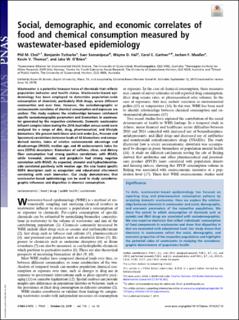| dc.contributor.author | Choi, Phil M | |
| dc.contributor.author | Tscharke, Benjamin | |
| dc.contributor.author | Samanipour, Saer | |
| dc.contributor.author | Hall, Wayne D | |
| dc.contributor.author | Gartner, Coral E | |
| dc.contributor.author | Mueller, Jochen F | |
| dc.contributor.author | Thomas, Kevin V | |
| dc.contributor.author | O'Brien, Jake W | |
| dc.date.accessioned | 2020-09-17T07:39:50Z | |
| dc.date.available | 2020-09-17T07:39:50Z | |
| dc.date.created | 2020-02-17T12:01:58Z | |
| dc.date.issued | 2019 | |
| dc.identifier.citation | Proceedings of the National Academy of Sciences of the United States of America. 2019, 116 (43), 21864-21873. | en_US |
| dc.identifier.issn | 0027-8424 | |
| dc.identifier.uri | https://hdl.handle.net/11250/2678150 | |
| dc.description.abstract | Wastewater is a potential treasure trove of chemicals that reflects population behavior and health status. Wastewater-based epidemiology has been employed to determine population-scale consumption of chemicals, particularly illicit drugs, across different communities and over time. However, the sociodemographic or socioeconomic correlates of chemical consumption and exposure are unclear. This study explores the relationships between catchment specific sociodemographic parameters and biomarkers in wastewater generated by the respective catchments. Domestic wastewater influent samples taken during the 2016 Australian census week were analyzed for a range of diet, drug, pharmaceutical, and lifestyle biomarkers. We present both linear and rank-order (i.e., Pearson and Spearman) correlations between loads of 42 biomarkers and census-derived metrics, index of relative socioeconomic advantage and disadvantage (IRSAD), median age, and 40 socioeconomic index for area (SEIFA) descriptors. Biomarkers of caffeine, citrus, and dietary fiber consumption had strong positive correlations with IRSAD, while tramadol, atenolol, and pregabalin had strong negative correlation with IRSAD. As expected, atenolol and hydrochlorothiazide correlated positively with median age. We also found specific SEIFA descriptors such as occupation and educational attainment correlating with each biomarker. Our study demonstrates that wastewater-based epidemiology can be used to study sociodemographic influences and disparities in chemical consumption. | en_US |
| dc.language.iso | eng | en_US |
| dc.publisher | National Academy of Sciences | en_US |
| dc.rights | Attribution-NonCommercial-NoDerivatives 4.0 Internasjonal | * |
| dc.rights.uri | http://creativecommons.org/licenses/by-nc-nd/4.0/deed.no | * |
| dc.title | Social, demographic, and economic correlates of food and chemical consumption measured by wastewater-based epidemiology | en_US |
| dc.type | Peer reviewed | en_US |
| dc.type | Journal article | en_US |
| dc.description.version | publishedVersion | en_US |
| dc.source.pagenumber | 21864-21873 | en_US |
| dc.source.volume | 116 | en_US |
| dc.source.journal | Proceedings of the National Academy of Sciences of the United States of America | en_US |
| dc.source.issue | 43 | en_US |
| dc.identifier.doi | 10.1073/pnas.1910242116 | |
| dc.identifier.cristin | 1794700 | |
| cristin.ispublished | true | |
| cristin.fulltext | original | |
| cristin.qualitycode | 2 | |

